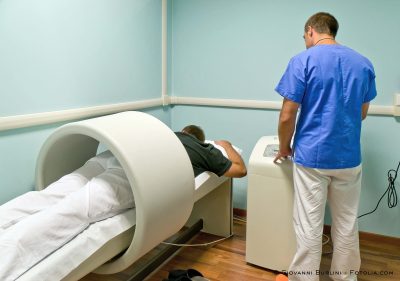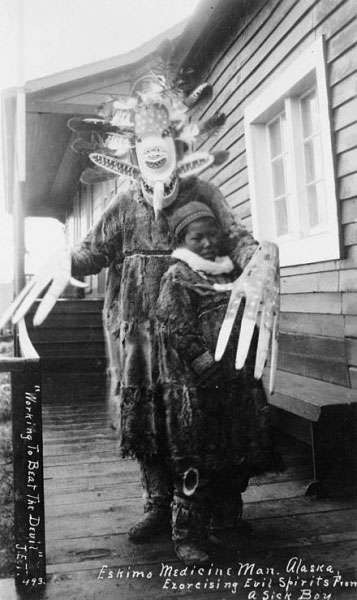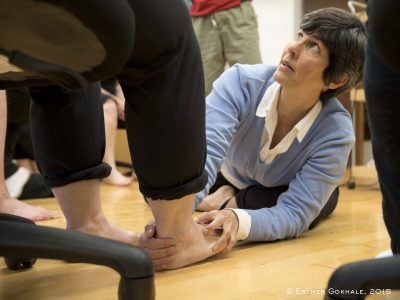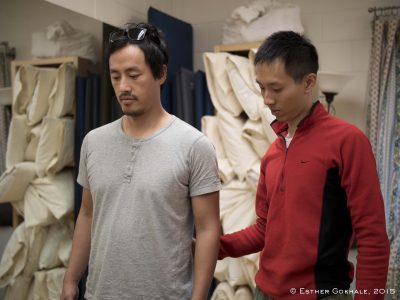There are few things as disempowering as a broken back. By "broken back" I mean to include painfully herniated disks, significant stenosis, as well as severe muscle tension and other less sustained spinal phenomena that constitute "non-specifc back pain" - and nonetheless hurt like heck. I remember this state clearly and have some journal entries to fill gaps in my memory - "...maybe I'm paying too much attention to my back. Maybe it's in my head..." 28 years ago, I felt like a broken straw.
Over the years, both as a healer and a teacher, I've been very interested in where the place of power resides in the process of healing. One of my influencers is Susun Weed, author of Healing Wise. Susun speaks with an authentic voice, is way out there (in her book, she transcribes her conversation with dandelions), and has some keen insights. Like her, I see the place of power in modern medicine to be in the medical machinery, the lab, the test results.

The place of power in modern medicine often lies in the lab and machinery
In the Shamanic tradition, the practioner is vested with special powers: he/she has mystical powers that the patient needs to return for - and depends on.

In Shamanic tradition, the place of power rests with the practitioner.
Yup'ik shaman exorcising evil spirits from a sick boy, Nushagak, Alaska, 1890s
In the Wise Person tradition, the place of power remains with the patient / student. The healer / teacher is a wise person whose role is similar to the role of a parent or advisor.

Gokhale Method teachers facilitate their students’ self-empowerment
A Gokhale Method teacher is trained to be a wise person. His/her function is to educate, facilitate, unencumber, and support the student. The student is seen as basically well-designed and, almost always, provided with a robust, functional frame. The problem is that modern culture hasn't nurtured healthy physicality. Poor furniture and clothing design, counterproductive guidelines like "sit up straight" and "chin up", and substantial drift in the recognized norms for spinal shape all contribute to a whopping 100 billion dollar a year problem (that's the number for the US alone) that is getting worse. Gokhale Method teachers step back from the band-aid approaches (even those of us who are trained to provide band-aid assistance when we wear other healing hats) and deftly approach the problem at its root. We teach our students how to restore their Primal Posture™- the shape they had when they were little children, and that their ancestors had. We help students peel away layers of misinformation and bad habit. We help students realize how powerful they really are. We guide them to Remember When It Didn't Hurt™. Not only can they get rid of pain and restore function, but they can experience high levels of energy, look and feel powerful, and strike that happy balance between being rooted in themselves and available to life.

Mex, our upcoming teacher in Singapore, helps his student,
Yongrim, learn to glidewalk.
Training practitioners of various sorts to become strong Gokhale Method teachers involves many significant, as well as subtle, shifts. I recall one chiropractor in teacher training remark "This is so different from chiropractic! In chiropractic we know which way we want to shape the body; here I have to listen to the body to see where it wants to go." A subtle shift that gets repeated every teacher training is eliminating the "Now I'd like you to...." With Zen-like pruning, we learn to eliminate the "I" where it's not necessary. The process is about helping the person find their way home - the teacher is the guide who knows the terrain better than the student. That's all.
With love and hearty wishes,
Esther
Join us in an upcoming Free Workshop (online or in person).
Find a Foundations Course in your area to get the full training on the Gokhale Method!
We also offer in person or online Initial Consultations with any of our qualified Gokhale Method teachers.



Comments
I love this!! Can we have
I love this!! Can we have this put into a format as a Hand out?
I'm so glad you love this!
I'm so glad you love this! Yes, of course you can use it - I'll request our staff to make a nicely designed pdf and we'll attach it here.
Great! Yes, exactly so. It's
Great! Yes, exactly so. It's so great to remember that each person is adequate to their life, and that the Gokhale teacher is simply reminding, encouraging, demonstrating, and facilitating the student to come back to their natural, powerful posture. Yes!
Thanks so much for this
Thanks so much for this updated and timely article. It is exactly what we need as a gentle reminder that it IS possible to remember when it did not hurt! I am looking forward to the PDF, too.
Norm
This is beautiful, Esther.
This is beautiful, Esther. Thank you.
Well, soooo, um, ahem I felt
Well, soooo, um, ahem I felt confortable with the shaman description in this post and with the photo which was clearly not shamanic. I asked my colleague, Narrye, to take a look and here is her response.
I appreciate your discussion of this topic and think you raise many important points about power and the healing relationship. However, as both as a Licensed Acupuncturist and a practitioner of shamanic healing, I have to correct some misunderstandings you seem to have regarding shamanism. First, shamans are not mystics. Their power is derived from a technique that enables them to connect and build relationships with "helping spirits" from non-ordinary reality. (A technique, by the way, that most people can readily learn, without having to be a "mystic.") There are many methods of shamanic healing, but I would say all of them are aimed at restoring lost power to the client, not taking it away. This is crucial to healing. (And here I should add that by "power" we mean wholeness and integration, not power as in bigger or better.) In shamanic cultures people who keep a strong connection to their "power" are not plagued by illness, pain, and accidents. An ethical shamanic practitioner would never create a dependency relationship with a client. Quite the contrary; the point of shamanic healing is to assist the client in returning to wholeness. When they experience a return of power, they don't need a shaman. My teacher, Dr. Michael Harner, used to say "keep your day job." Which was his way of telling us to stay humble because any success we have with a client really doesn't come from us, but rather from the spirits we work with. And finally, you use a completely inappropriate photo to illustrate what I can only imagine you are guessing is some sort of shamanic healing. I suggest you just take it down. It's embarrassingly irrelevant and misleading. Otherwise, thanks for raising this very important topic for discussion.
Narrye Caldwell, L.Ac.
Hi Diana, Thanks for posting
Hi Diana,
Thanks for posting your thoughtful comment! You are entirely correct about the image being shoddy, inauthentic (the result of my not giving my team enough time to search the internet and signing off on a bad picture - my fault), and, I can understand, embarrassing to someone in the shamanic tradition. I'm sorry for the insensitivity! Please thank your colleague Narrye for the comment. I will have this image replaced by an authentic one I have in hand (but am not quite well-versed enough in our backend technology to replace myself, so I'll leave it to our techies to replace later tonight or tomorrow first thing).
That done, i must draw your attention to a couple of important details in my description of the power relationships in healing. Power residing within a shaman is not at all the same as saying that shamans take peoples' power away. Indeed, if they are good shamans, I would hope they empower people, but they are using special powers to do so!
Which brings me to another point that I did not adequately explain. This is not meant to be a diss'ing of Shamanic traditions or modern medicine. There is room and need for all kinds of healing and I'm certainly not presenting a hierarchy of better and worse healing ways. If I were to have a severe bacterial infection, it's modern medicine and blood tests I would want! And if I were to feel really down, it's a trusted Shaman-like authority I might like to have take care of me and hand my power over to!
I've had powerful personal experiences with shamanic healing; I've been invited to speak at shamanic events; this summer I hope to explore what's thought to be one of the oldest Shamanic traditionss when I visit the indigenous Sami people in Northern Sweden. This is just the beginning of my exploration of Shamanic healing. I'm thankful for the nudge in refining at least some of my ideas. To those of you who wish to explore this further, this fascinating article on Wikipedia is interesting. It describes neo-Shamanism, which may be version of Shamanism Narrye is referring to?
Hi Esther,Although I see that
Hi Esther,
Although I see that you wrote the place of power lies with the Shaman twice now, once in the text once in the caption of the picture which would be great Halloween costume, one is still left with the impression that the patient is powerless or has relinquished their power. This because the next sentence reads "In the Wise Person tradition, the place of power remains with the patient / student. The healer / teacher is a wise person whose role is similar to the role of a parent or advisor." Although you have not said "in comparison" by placement and context it is inferred that power does not remain in Shamanism. In your comments response you wrote " And if I were to feel really down, it's a trusted Shaman-like authority I might like to have take care of me and hand my power over to!" I think at issue here is something which I did not take into account at first; that this is an Op/Ed piece. As such anything you say is fine as long as it is clear it is your opinion. However this could be someone's first introduction to Shamanism, one wants, if brevity is an issue, to be as accurate as possible. Speaking of accurate the type of Shamanism that Narrye practices is best found by Googling her teacher's name, which she referenced, Dr. Michael Harner.
I do believe that, in some
I do believe that, in some renderings of Shamanism, the patient/subject has little power (powerless is too strong a word for what I'm saying) or does indeed relinquish power to the Shaman. The image above (which I find moving - not sure if that's what you mean by "would make a good Halloween costume" - and is certainly authentic) is a very clear example of that - the costume is large, overpowering, otherwordly and the boy is sick, still and little. I think the imbalance of power is the point here. The boy has been literally put into the hands of the Shaman.
From Wikipedia (not the ulitmate authority, I know, but amazing, right?): There is an endeavor in some contemporary occult and esoteric circles to reinvent shamanism in a modern form, often drawing from core shamanism—a set of beliefs and practices synthesized by Michael Harner—centered on the use of ritual drumming and dance, and Harner's interpretations of various indigenous religions. Harner has faced criticism for taking pieces of diverse religions out of their cultural contexts and synthesising a set of universal shamanic techniques. Some neoshamans focus on the ritual use of entheogens,[citation needed]and also embrace the philosophies of chaos magic[citation needed] while others (such as Jan Fries[211]) have created their own forms of shamanism.
Regarding this post being an op-ed, that goes without saying. And if you joind us on the other side of this blog (which you are heartily invited to do), it would presumably be your op-ed. And with that, I would like to invite readers out there to please submit suggestions of posture-related articles they would be happy to write - there's room for more than one set of opinions here!